Key takeaways:
- Visual hierarchy is essential for guiding viewers’ attention and enhancing engagement through size and typography.
- Color contrast and psychological impact of colors significantly influence a poster’s emotional appeal and readability.
- Engaging content, clarity, and appropriate tone resonate with audiences, making emotional connections through storytelling.
- Effective use of images and negative space can enhance message delivery and create a visually compelling design.
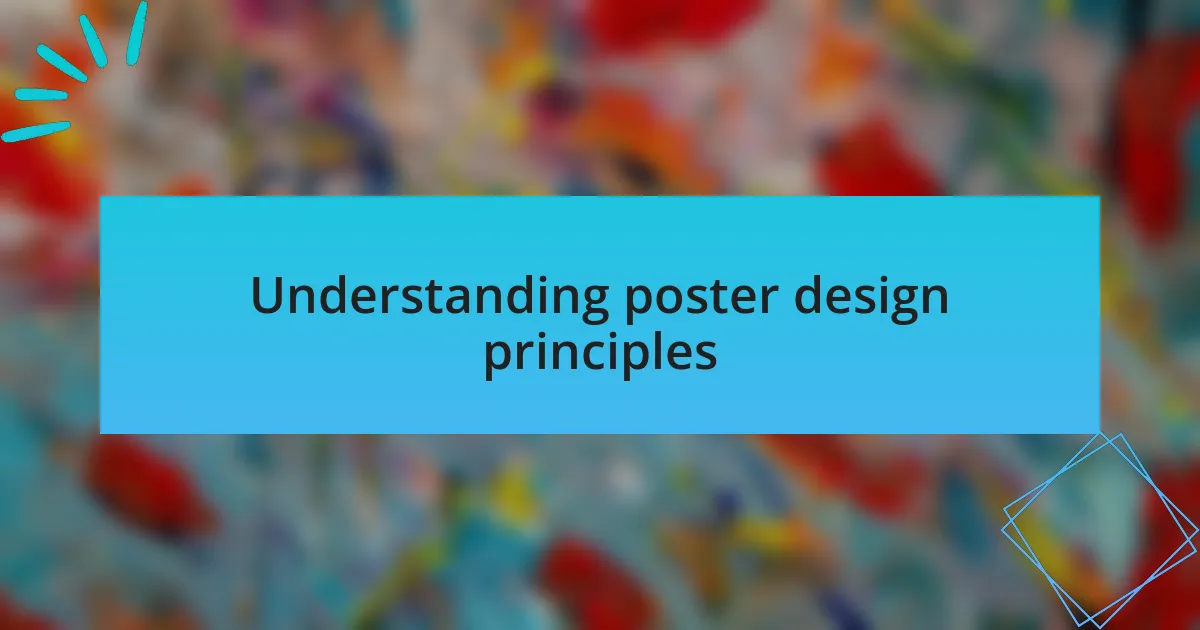
Understanding poster design principles
When I think about poster design principles, one aspect that stands out is the power of visual hierarchy. It’s fascinating how the arrangement of elements can guide a viewer’s eye, drawing them toward the most essential information. I remember designing a poster for a community event, and I realized that placing the event name at the top in bold lettering really captured attention right away.
Color contrast is another principle that fascinates me. Choosing colors that contrast well not only makes text readable but can also evoke emotions, setting the mood for your message. I once created a poster using vibrant reds and deep blues for a charity gala, and the response was incredible. People felt energized just by looking at it, which made me appreciate how much emotion can be conveyed through color alone.
Lastly, the psychology behind white space cannot be overlooked. I often find that when I leave space around elements, it allows the viewer’s eye to breathe and the message to resonate. During a recent project, I applied this with a minimalist design, and the feedback was overwhelmingly positive. It seems that sometimes, less truly is more; it’s about creating a balance that feels inviting and not overwhelming for the audience.
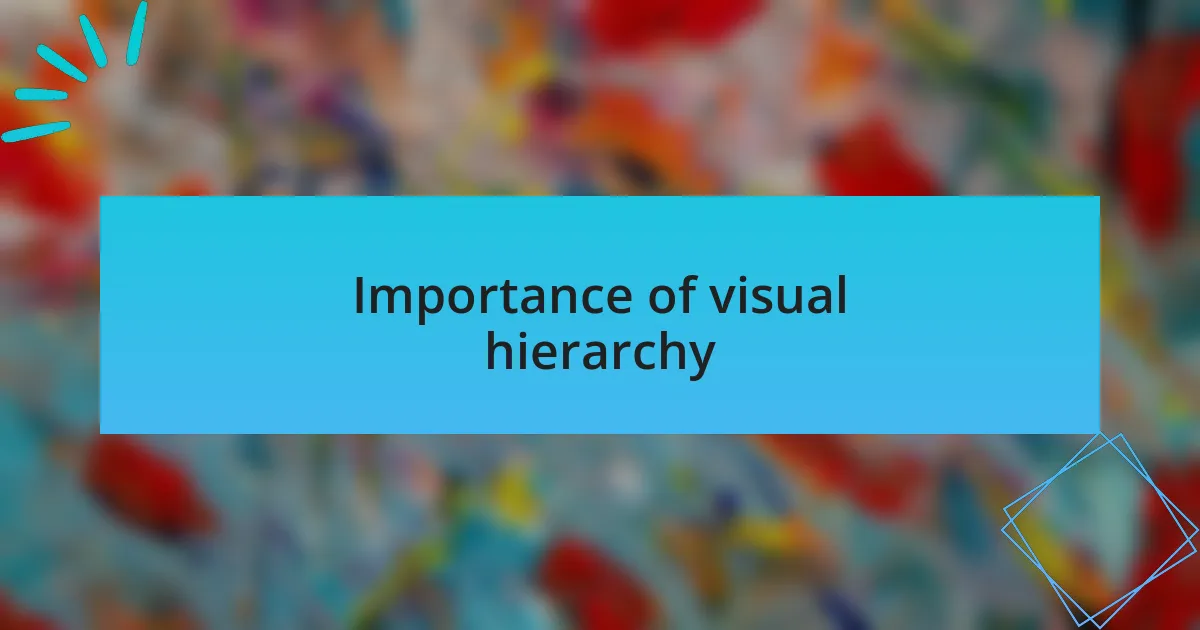
Importance of visual hierarchy
Visual hierarchy is crucial because it influences how information is consumed. When I organized the elements of a poster for a local art exhibit, I deliberately sized the featured artist’s name larger than the rest of the text. This choice not only highlighted the star of the show but also made the information flow intuitively. Isn’t it interesting how a simple shift in size can completely change the viewer’s experience?
I’ve learned that the use of typography plays a significant role in visual hierarchy too. For a campaign promoting a wellness workshop, I experimented with various font styles. By using a bold, modern font for the workshop title and a lighter font for the details, it created a clear distinction between the main focus and supporting information. It’s a powerful reminder of how thoughtful typography can act like a conductor guiding the viewer’s attention.
In my experience, the arrangement of elements is equally important. I recall a time I designed a poster for a charity run, placing the date and location at the bottom in a slightly smaller font. This was a deliberate choice because I wanted to lead viewers through the essential details first. I realized that making the path clear for the viewer—almost like telling a story—enhances their understanding and engagement. What do you think happens when emotional connections are built through thoughtful design? It’s a game-changer.
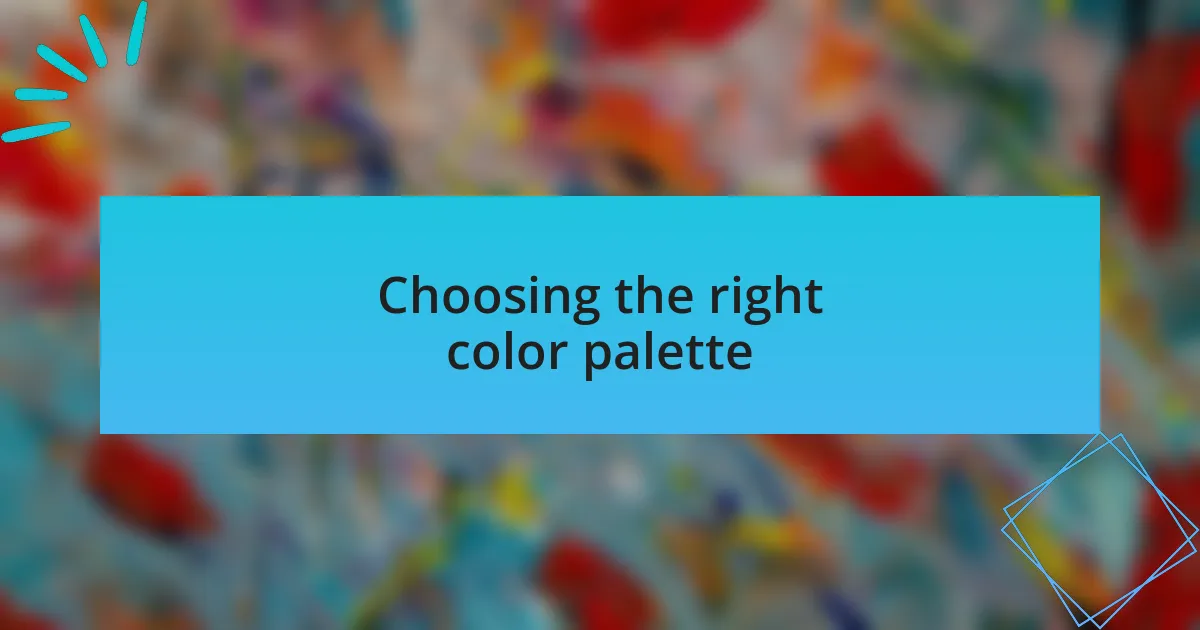
Choosing the right color palette
Choosing the right color palette can transform a poster from ordinary to extraordinary. Reflecting on my time designing an event poster for a community art fair, I remember selecting warm, inviting colors that resonated with the local culture. This choice didn’t just enhance the visual appeal; it created an emotional connection with viewers and sparked their interest in attending. Isn’t it fascinating how colors can evoke specific feelings and reactions?
When I think about color combinations, my experience with contrasting hues stands out. I once designed a promotional poster for a music festival and opted for a vibrant blue background paired with bright yellow text. The contrast not only captured attention but also made the information clear and accessible. This made me realize that using color intentionally can enhance readability, guiding the viewer’s eye over the content effortlessly.
It’s important to consider the psychological impact of colors as well. For instance, during a project for a mental health awareness campaign, I chose soothing greens and blues, aiming to convey a sense of calm and trust. I noticed how those colors resonated with the audience, making the message more impactful. How do you think the emotions associated with color influence the effectiveness of your design? I believe taking this into account is critical for creating compelling visuals.
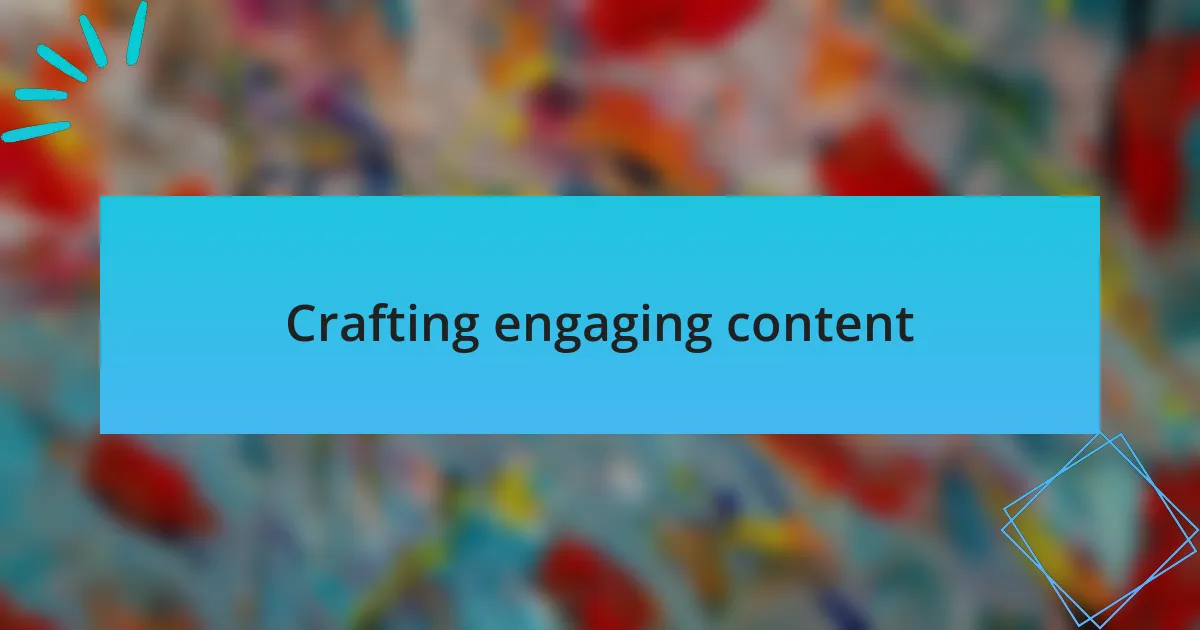
Crafting engaging content
Crafting content that captivates begins with understanding your audience. I recall when I worked on a poster for a local charity run; I chose to highlight personal stories from participants. Sharing their challenges and triumphs added a relatable touch, allowing viewers to connect emotionally. Have you ever considered how a story can draw people in? I find that a well-placed anecdote can make a world of difference in engagement.
Then there’s the importance of clarity in your messaging. Once, I created an informational poster for a health fair, ensuring that every piece of text was straight to the point. I used bullet points and short sentences to convey essential tips on wellness. This experience taught me that concise content not only respects the reader’s time but also makes the information more memorable. Don’t you agree that when we streamline our messages, they resonate better?
Lastly, the tone and voice you choose can shape how your message is received. In a recent project for a youth event, I adopted a playful, inspiring language that encouraged participation. I noticed that this approach created a sense of excitement and positivity around the event. It made me realize how vital it is to align your tone with the interests of your audience. What kind of voice do you think would resonate best with your viewers?
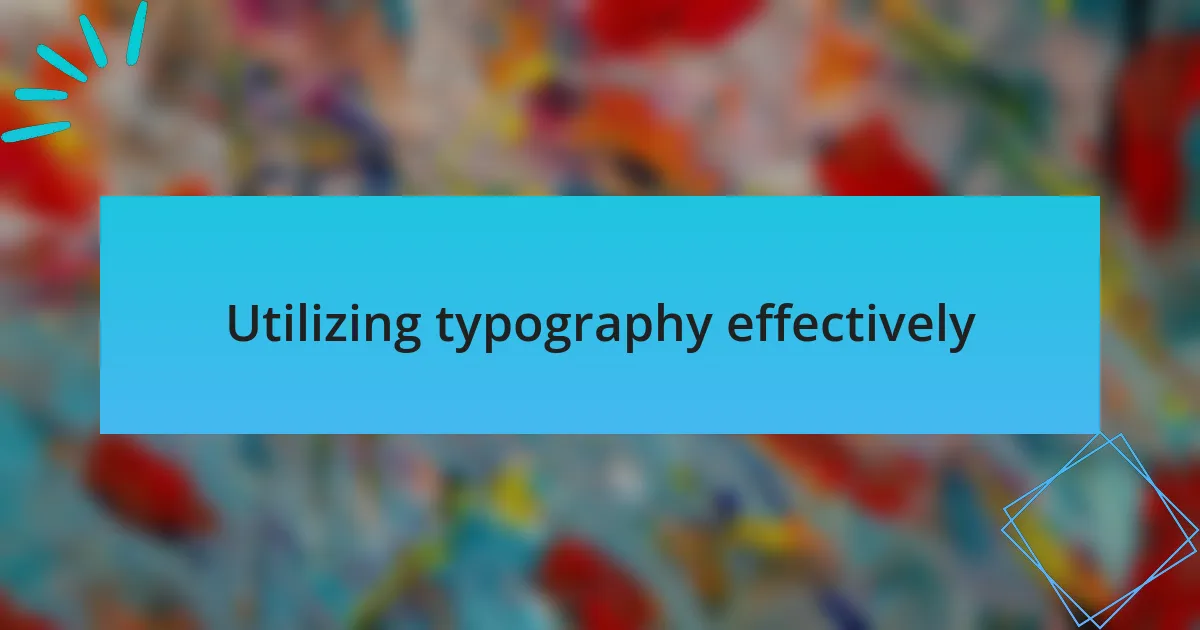
Utilizing typography effectively
One of the most impactful elements in poster design is typography. I remember designing a poster for a music festival, where I chose bold, vibrant fonts to reflect the energy of the event. The typography not only caught the eye but also conveyed the excitement of the lineup. Have you ever noticed how a particular font can evoke specific feelings? I truly believe that the right typeface sets the mood and draws in the viewer instantly.
When it comes to hierarchy in typography, I’ve learned that not all text carries the same weight. For example, while working on an educational poster, I used larger, bolder headlines to grab attention, followed by smaller text for details. This approach guided the viewer’s experience, making it clear what was most important. It’s fascinating how a simple change in size can lead the eye to where it needs to go. Does your typography hierarchy effectively direct your audience’s attention?
Using color in typography can also change the game significantly. I once experimented with contrasting colors for a community event poster, choosing a bright hue for the headline and a softer shade for supplementary information. This not only created a striking visual impact but also enhanced readability. It made me realize that color choice isn’t just aesthetic; it can improve how your message is perceived. Have you thought about how color influences your typography choices?

Incorporating images and graphics
Incorporating the right images and graphics into a poster can dramatically transform its appeal. I recall a project where I used a captivating photo of a sunset to promote a local beach cleanup event. The image not only captured attention but also evoked a sense of urgency, prompting viewers to envision the beautiful spot we were fighting to preserve. Have you ever realized how a single image can instantly convey the essence of an event?
Graphics play a crucial role in breaking up text and making the poster more engaging. For instance, while designing an informational poster for a health campaign, I used infographics to present statistics visually. It helped distill complex information into digestible pieces, making it easier for people to grasp key points. This experience taught me that visuals can simplify messages and enhance understanding, creating a more impactful communication.
I often find that the placement of images can either enhance or disrupt the flow of a poster. On one occasion, I experimented with an unconventional layout for a fashion event, placing images at diagonal angles. The decision added dynamism and drew the viewer’s eye across the design. Have you thought about how the arrangement of visuals impacts the overall message you want to convey? Each choice we make with graphics can either strengthen or weaken our narrative.
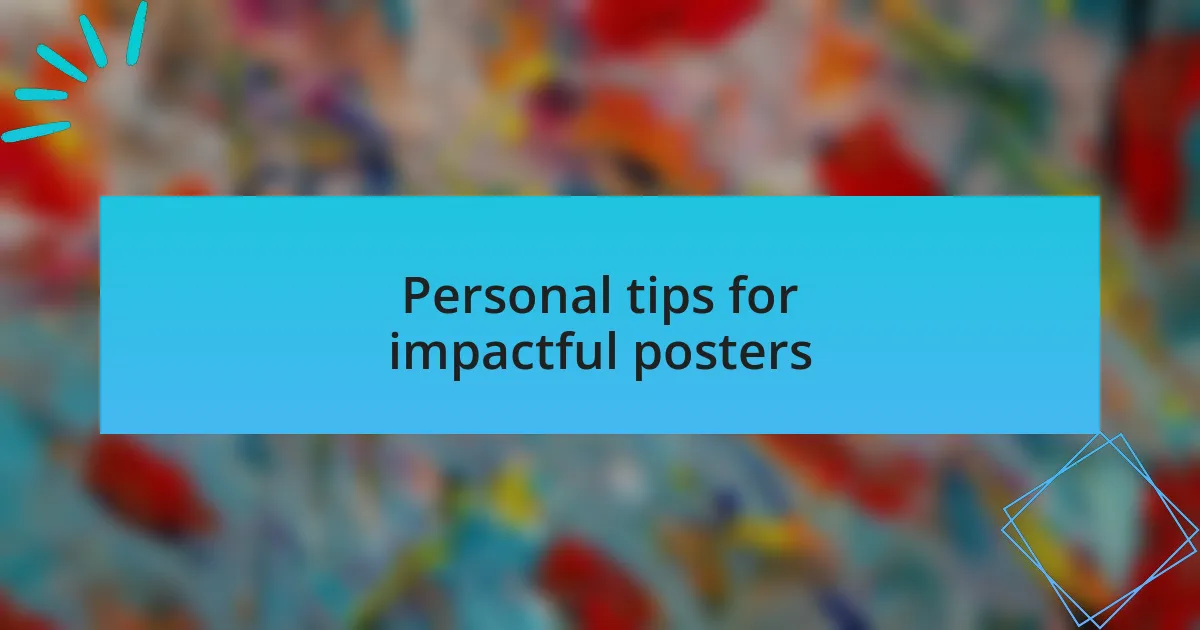
Personal tips for impactful posters
When it comes to creating impactful posters, I always emphasize the importance of a strong focal point. I remember designing a poster for a community event and chose a striking headline in bold typography that captured the core message. It immediately drew attention, and I could see the audience’s curiosity piqued. Have you ever noticed how a powerful headline can ignite interest in a larger narrative?
Color choices are also pivotal in setting the emotional tone of a poster. In one of my recent projects, I opted for a vibrant palette to promote a local art festival. The bright colors not only conveyed excitement but also mirrored the creativity of the event. Honestly, I find myself drawn to how different hues can elicit various feelings. What colors resonate with you when you think about making a statement?
Lastly, I believe that the use of negative space can elevate a poster’s design by allowing important elements to breathe. There was a time when I felt compelled to fill every inch of space, thinking it would create more interest. However, after learning to embrace simplicity, I created a poster that let its message shine through with ample white space. It taught me that sometimes, less truly is more. Have you experimented with empty areas in your designs? You might be surprised by the clarity it can bring to your message.